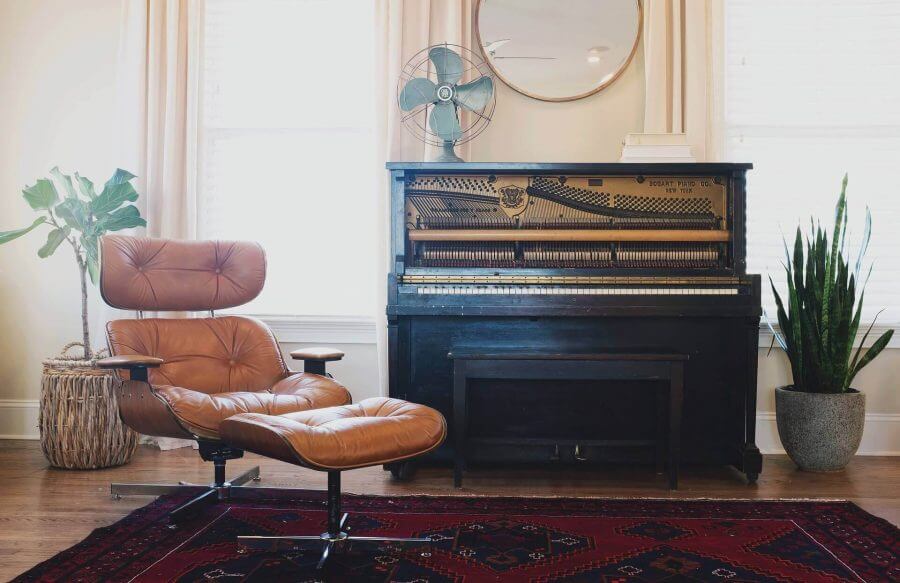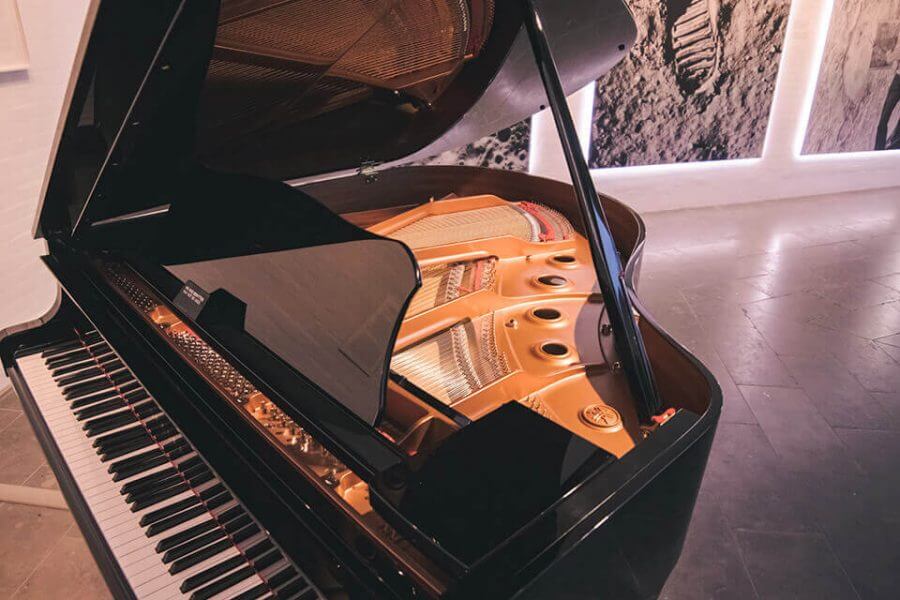

How to Move a Piano Safely by Yourself
Posted in Moving Essentials on October 26, 2020
Whether your piano is an often-used musical instrument, or just a family heirloom standing in your living room, you need to ensure it’s cared for when the relocation time comes. Because it’s a bulky item holding delicate mechanical parts and strings under high tension, you’re probably wondering how to move a piano. When choosing to handle its relocation on your own, you should think twice and consider the option of entrusting this process to professionals.
Even the smallest upright can be incredibly massive and troublesome to maneuver. However, if hiring long distance movers is not in line with your moving budget or doesn’t fit into your timing, you’ll probably be thinking about the question: can you move a piano by yourself? Yes, you can, but you’ll just have to do a good bit of planning. Also, keep in mind that the most popular pianos, on average, weigh between 480 to 1,400 pounds. With your piano’s weight and price, it’s needless to say that it should be handled with the utmost care, especially if there are narrow hallways or steep stairs involved. Professionals can easily overcome these obstacles.
But if you’re still confident that you can move this musical instrument by yourself, we’ve prepared some helpful tips to help you find the answer to the question: What is the easiest way to move a piano?
Necessities for Moving a Piano Yourself
This process can be done by yourself, but it requires a lot of help and preparation steps. Besides friends and family members near you to help you with this oddly shaped and hefty musical instrument, you need to obtain the right equipment and perform preliminary measures. So, let’s find out what factors should be fulfilled when planning to move a piano yourself.
Get the Right Equipment
To protect both yourself and the instrument when relocating, you should include some additional items on your moving to-do list, necessary to move your piano:
- Four-wheel dolly
- Dolly straps
- Moving straps
- Weightlifting straps
- Ramp
- Van/truck
- Work gloves
- Plastic wrap or dense cloth/blanket
- Heavy-duty tape.
Moving Pads Are the Most Important Supplies
Since your instrument can be easily damaged, think about providing it with cushioning. In that regard, moving pads can be considered among the moving essentials. These thick and protective materials also called moving blankets have the same goal – to protect your cargo from scratches. Pads, a blend of cotton and polyester mesh, are usually used by both professional cross country movers and nonprofessionals to protect objects that are made of wood or have any other sensitive surfaces.
They are similar to the traditional blanket but are heavier in weight. When covering your instrument, two blankets may be the best solution. Place one pad on the top and fasten it with rubber bands. You can flip your item on to its side and secure your cargo from both sides with moving pads. Now, you’re probably wondering Can you put a piano on its side to move it? As a matter of fact, you can. Moving on its side or back won’t harm your instrument. It can be rotated or tilted without doing damage. If it’s handled unprofessionally and when it’s dropped or bumped, naturally – damage occurs.

Steps to Perform Before Moving Your Piano
Once you’ve decided to move your instrument by yourself, your major goal should be to make your DIY move as smooth as possible. For that reason, there are some steps you should be familiar with in order to relocate your pianoforte without a hitch.
Don’t Start Anything Without Taking Measurements
When moving a piano yourself, the dimensions of the instrument are essential, as well as the path you’re planning to move it along. Keep in mind that all doorways, hallways, and stairs in your current place should be included, and those in the future home too. The same handy moving hacks you will be using when relocating some pieces of your furniture for a new apartment should apply here. They are necessary to ensure that the instrument will be transported easily when the relocation day arrives.
It’s good to know there are two major types of pianos: upright or vertical and baby grand pianos. They are different in their dimensions, weight, and relocation needs. Don’t worry, we’ll provide you with all the details very soon.
Clear the Path
Once you lift your 700 lb or 1000 lb instrument, the last thing you would like to worry about is that a small coffee table or your kid’s rocking horse is on your way. Also, you should think about protecting your floors and walls from the piano’s move. You can cover the instrument’s corners with extra towels or baby-proof bumpers to secure both your interior and the valuable pianoforte.
You’ll Need Strong Friends to Move a Piano Efficiently
If you’re not sure how many friends you should engage to move the hefty instrument, we’ll help you. You should find at least four strong people for heavy lifting and guiding to and from the moving truck. If your piano belongs to the concert grand pianos category (over 8’10”,) you may need more people to help you with this process.
Wrap Your Musical Instrument
Whatever type of piano you have, it must be wrapped before loading onto a moving truck. Since upright and grand instruments differ in dimensions and shapes, they require different equipment and approach during the relocation process.

How to Move an Upright Piano
When it comes to moving an upright piano, there are several steps to follow:
- Wrap the lid over the keyboard and secure it with tape.
- Use plastic wrap or cloth for the pedals. Fasten them with tape too.
- Wrap all the sides of the instrument (the front, back, and sides) with pads and secure with tape.
So, these are preparatory steps when wondering how to move an upright piano. Just be sure to fix everything tightly and ensure the best protection while relocating your vertical pianoforte.

Moving a Grand Piano
To prepare grand pianos for a move, be sure to follow these critical steps:
- Lower and fasten the top lid with tape.
- Disassemble the pedals and legs.
- Protect the piano’s body by wrapping all sides with moving blankets. Secure them tightly with tape.
- Watch out how your movers lift and lower the instrument – since it has no legs, they should keep it stable.
As you can see, when looking for the right answer to how to move a grand piano, the most important factor is safety and care.
Why It’s Important to Take All Legs Off the Grand Piano
The piano’s legs are designed to carry its weight and hold it steady. Simply put, if your instrument has no wheels, it’s definitely not meant to be relocated without being dismantled beforehand. Even if it does have them, those wheels are not meant for rolling. Apart from that, the legs are the most prone to breakage, and if you try to lift it by these elements, the weight balance can shift easily. This can cause a leg to snap. Also, this might be extremely dangerous for people underneath the instrument.

How to Move Your Music Instrument
After protecting your piano thoroughly, place it on the dolly, and fix it with straps or rope. For an upright piano, you’ll need piano dollies, and for a grand piano, you should obtain a special piece of equipment – a piano (skid) board. If you need to move it down a staircase, make sure to set up a ramp beforehand. It will help you guide it downwards. Your helpers should make slow and steady steps in order to stabilize the instrument. If you’re wondering how to pack a moving truck like a pro, you need to roll the instrument onto the truck and secure it safely using straps to tie it down.
Once it arrives at your new place, you should re-tune the instrument. Still, sometimes changes in temperature and humidity can affect your instrument, so it may go out of tune after the relocation. According to piano technicians, you should let your instrument adjust to a new home for at least a month before tuning.

How Much Does It Cost to Move a Piano
After creating your household inventory list and packing all the items in boxes, you might be wondering how much do movers cost. The relocation costs shouldn’t be a problem since long-distance movers usually charge by the weight of your packages. But, what should you expect when it comes to the piano’s relocation costs? If you decided to choose this option instead of relocating the instrument DIY, you’ve opted for your own peace of mind.
When looking for piano removers and asking for the cost estimation, several things should be determined:
- You should specify the type of your instrument
- Measure the size of your instrument precisely
- Find out the details of the model and the make
- Distance is also a relevant factor – the longer the distance, the higher the moving expenses
- Stairs are usually considered to be the biggest challenge since it might be risky. Long-distance moving companies typically charge an extra fee for this task.
So, many factors should be considered if you’re planning to hire a cross country moving company and they can vary from one company to the next. That’s why you should contact your prospective movers and find out all the relevant information.

Factors That Complicate a Piano Move: Moving Up or Down the Stairs and Other Difficulties
Whether you decide to move a piano yourself or by hiring pros, some factors can bring a headache even to the most professional crew. So, here’s what kind of difficulties you and your movers should know when relocating your bulky item from your home to the moving truck and reverse:
- The access point – for example, if your instrument can go only through a balcony door on the higher story, the professionals must use a lift or crane
- Low ceilings, thin hallways, narrow doorways, etc.
- On-site distance – try to clear an area for the truck to park as close to the instrument’s access point as possible
- Changes in temperature and humidity can affect your piano’s overall condition – find out if climate-controlled transportation or temperature-controlled storage units are available services
- Stairs – if your stairs are narrow with curves or ornate banisters, these features may make the process more complicated. This is the main reason why people call experts who use weightlifting straps, skip board, and dolly with knowledge and experience.

Best Way to Move Piano Is With Professional Moving Help
If you’re unsure how to move a piano downstairs or up, take into consideration hiring pros to do this difficult job instead. Dealing with other tasks related to organizing your relocation, packing process, and preparing tons of important documents, choosing long-distance movers can be an excellent choice. They will take care of your valuable instrument efficiently and transport it to your new location without damage. Just make sure to avoid moving scams and choose reliable professionals. In the end, relocating your instrument across the country without a scratch could be an excellent reason to tip your movers and write a positive review.




